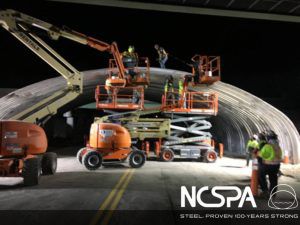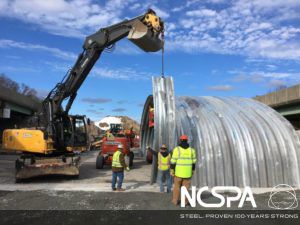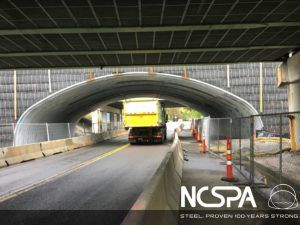By: Contech Engineered Solutions
The Original Plan: A Traditional Temporary Bridge

Firstly, a significant infrastructure project in Attleboro, Massachusetts, aimed to replace twin three-lane bridges carrying I-95 over North Avenue. Originally, the project stipulated the construction of a traditional temporary bridge in the median to accommodate traffic flow during the replacement of each bridge. However, J.F. White, the awarded contractor, proposed an innovative alternative: a deep corrugated structural plate Buried Bridge. This proposition, importantly, addressed the challenge of maintaining two lanes of North Avenue traffic and pedestrian sidewalks beneath the interstate. It also preserved the existing I-95 road elevation. Consequently, this marked the inaugural use of such a deep corrugated structural plate Buried Bridge on a Massachusetts Department of Transportation initiative. It showcased the immediate Buried Bridge benefits and a novel approach to temporary bridge construction.
The Buried Bridge Breakthrough: Cost and Time Savings

Furthermore, the implementation of this value-engineered Buried Bridge resulted in substantial cost savings. To illustrate, the Buried Bridge came in approximately $750,000 less expensive than the originally specified temporary bridge structure. Moreover, when accounting for the elimination of deep foundations, bridge abutments, and the removal of temporary bridge abutments and piles, the total cost savings are substantial. Approach slabs and the heavy equipment required for construction and deconstruction were also not needed. The total cost savings are estimated to exceed $1,000,000. Additionally, the project experienced a time savings of over four months. For instance, the contractor was granted a single weekend to close North Avenue and, subsequently, completed the assembly of the 100-plate structure in a mere 24 hours. Therefore, the efficiency of the Buried Bridge highlighted the profound Buried Bridge benefits. It demonstrated a significantly faster alternative to traditional temporary bridge methods.
Safety and Efficiency: The Undeniable Advantages

Moreover, the Buried Bridge significantly enhanced safety protocols. Indeed, by eliminating the need for heavy equipment such as pile drivers and cranes, and by drastically reducing construction time, the project minimized potential hazards. In other words, this project effectively demonstrated all the benefits of utilizing Buried Bridges as a viable alternative. These include cost, time, foundation, safety, and Accelerated Bridge Construction (ABC) benefits. This scenario is applicable to numerous projects. Ultimately, this case study underscores the myriad Buried Bridge benefits that can be realized through innovative engineering solutions. It effectively redefines the standards for temporary bridge installations. For example, instead of using metric measurements, it is important to note that the length of the plates was not specified. However, the number of plates was 100.
For additional details regarding this project, please visit Contech Engineered Solution.
Related Stories
Smith Ford Crossing – 2015 Corrugated Steel Pipe and Pipe Arch Project of the Year (Opens in a new browser tab)
Project Spotlight: CVA Randolph Loop Track Bridge (Opens in a new browser tab)
Eco-Friendly Military Access Roads: Deep Corrugated Buried Bridges Reduce Environmental Impact (Opens in a new browser tab)